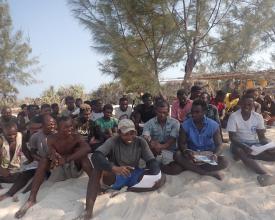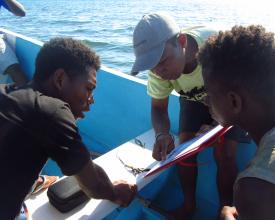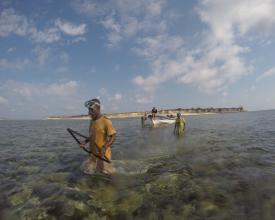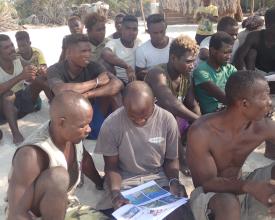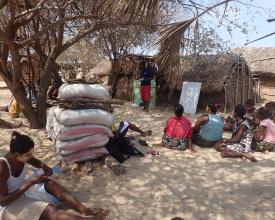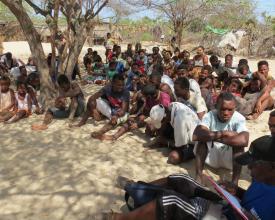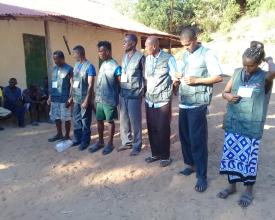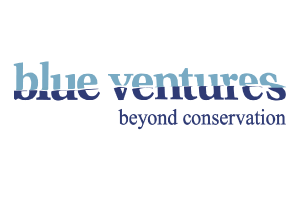
De la cartografía participativa a las medidas de gestión de las praderas marinas
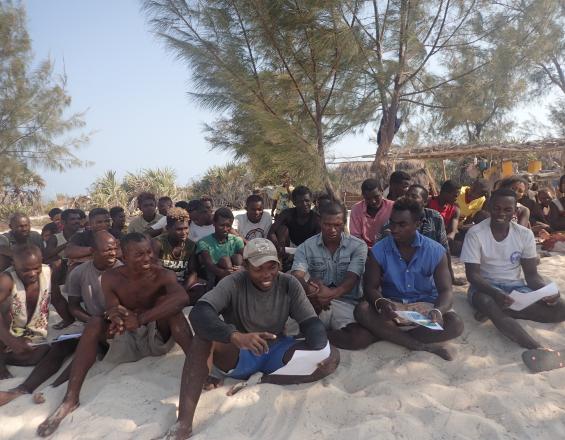
Las islas Barren están situadas frente a la costa de Maintirano, en la región de Melaky, en la costa occidental de Madagascar. Esta AMP (4.300 km²) está cogestionada por la asociación de pescadores artesanales Vezo Miray Nosy Barren.
Aquí se dan las condiciones adecuadas para el desarrollo de praderas marinas, hogar, entre otros, de peces aguja capturados por los pescadores artesanales cuando hace mal tiempo.
Para preservar este hábitat fue necesario delimitar las zonas de gestión con la participación activa de la comunidad. La cartografía participativa reveló una superficie de praderas marinas de unas 600 hectáreas. Las comunidades recibieron información sobre la extensión de las praderas marinas y asistieron a sesiones educativas sobre los servicios ecológicos que prestan, con el fin de concienciarlas.
Las comunidades llevaron a cabo el seguimiento adoptando el enfoque de vigilancia de las praderas marinas para evaluarlas e introducirlas en la técnica de seguimiento. Se organizó una sesión de intercambio de datos con los miembros de la comunidad para debatir las medidas de gestión.
Contexto
Défis à relever
- Un bajo nivel educativo entre los pescadores locales, caracterizado por su dificultad para leer mapas y comprender algunos de los servicios ecológicos de las praderas marinas, como el secuestro de carbono y la fotosíntesis.
- La escasez de conocimientos entre las comunidades sobre las praderas marinas, lo que les dificulta tomar decisiones adecuadas y oportunas y priorizar su protección;
- El uso de artes de pesca de arrastre de fondo, incluidas las redes de cerco de playa utilizadas por los pescadores artesanales y las redes de arrastre de camarones industriales, supone una amenaza directa para este hábitat, aunque está prohibido en esta zona. Estas artes aumentan la turbidez del agua como consecuencia de la suspensión de sedimentos, lo que limita la capacidad fotosintética de las praderas marinas;
- La importante escorrentía de sedimentos y arena debida a la erosión aguas arriba y costera tiene impactos similares en este hábitat;
- La perturbación antropogénica de las praderas marinas es significativa, debido al pisoteo de los pescadores durante la marea baja, ya que acceden a los bajos del arrecife donde buscan pulpos, pepinos de mar y diversos moluscos.
Ubicación
Procesar
Resumen del proceso
Estos bloques de construcción describen los pasos que van desde la recogida de datos sobre las praderas marinas hasta la toma de decisiones sobre las medidas de gestión. El enfoque de seguimiento participativo desarrollado en McKenzie et al. (2003) es apropiado para que las comunidades locales conozcan los recursos de las praderas marinas. Sin embargo, este seguimiento va precedido de una cartografía participativa de los límites de las praderas marinas utilizando los conocimientos locales. Estas dos actividades demuestran que los miembros de la comunidad local están plenamente integrados en el proceso.
Sin embargo, esta participación en la recogida de datos no es suficiente para garantizar su capacitación y participación en el proceso de toma de decisiones. Estos datos deben transmitirse a las comunidades, ya que constituyen un puente hacia la toma de decisiones de la comunidad local. A menudo, las comunidades son desposeídas de los datos sobre ellas, recogidos por terceros. Garantizar que la información esté en sus manos fomentará las capacidades locales, reforzará los conocimientos ecológicos locales y dará impulso a la conservación. Así, las comunidades podrán tomar medidas de gestión muy rápidamente y con gran capacidad de respuesta a través de sus convenios locales.
Bloques de construcción
Cartografía participativa
-
Trabajamos con la comunidad para evaluar la percepción del estado de las praderas marinas y las amenazas locales;
-
Durante una reunión de la comunidad local, dibujamos los límites de las praderas marinas en una imagen de satélite proyectada con la ayuda de los participantes;
-
Junto con los representantes de los pescadores locales, los líderes de la comunidad/asociación y los ancianos del pueblo que conocen bien la zona, recogimos las coordenadas GPS de las praderas marinas (puntos del perímetro alineados con los mapas comunitarios creados en el paso anterior);
-
A continuación, proyectamos las coordenadas GPS recogidas en imágenes por satélite para que la comunidad local las validara durante una segunda reunión.
Factores facilitadores
-
La cartografía participativa no era completamente nueva para las comunidades, ya que anteriormente se habían llevado a cabo ejercicios similares durante la cartografía de las zonas de pesca y la implantación de reservas temporales;
-
La implicación de las comunidades locales a lo largo de todo el proceso conduce a una verdadera aceptación;
-
Integración de los conocimientos de las comunidades locales para una recopilación de datos fiable.
Lección aprendida
-
La primera reunión de la comunidad local fue muy útil para hacerse una idea de los límites y facilitó la validación durante la segunda reunión. La comprobación sobre el terreno mediante la recogida manual de puntos GPS proporcionó datos más precisos;
-
Los datos eran más fiables gracias a los conocimientos de la comunidad local.
Seguimiento participativo
-
Proporcionamos formación de refresco sobre los servicios ecológicos de las praderas marinas;
-
Formamos a representantes de los pescadores locales en protocolos de seguimiento (metodología Seagrass Watch (McKenzie et al., 2003));
-
Llevamos a cabo la evaluación de las praderas marinas con pescadores formados que recopilaban datos sobre la ubicación de los límites/borde, las especies, el porcentaje de cobertura, el tipo de sedimento y la profundidad;
-
Recogimos los datos en papel y los introdujimos en una base de datos informática antes de analizarlos.
Factores facilitadores
-
Gracias a las diversas actividades de concienciación sobre la conservación, las comunidades se interesaron cada vez más por la salud de los ecosistemas, a los que se referían como su "despensa" cuando hacía mal tiempo.
Lección aprendida
-
Aunque la metodología se adaptó para que la utilizaran los pescadores locales, fue necesario impartir formación de refresco para que pudieran llevar a cabo el seguimiento.
Información e interpretación de los datos
-
Analizamos e interpretamos los datos recogidos durante el seguimiento, la cartografía y las reuniones comunitarias;
-
Durante las reuniones comunitarias locales, utilizando enfoques visuales a través de imágenes, proyección de diapositivas y debates, se presentan a la comunidad los resultados y las interpretaciones de la cartografía y el seguimiento de las praderas marinas, así como las percepciones del estado de las praderas marinas. De este modo, la comunidad recibe información sobre los datos recogidos y su interpretación.
Factores facilitadores
-
La información sobre los datos puede ayudar a los miembros de la comunidad local a comprender mejor sus actividades pesqueras y los hábitats relacionados, promover el debate entre ellos y sugerir medidas adecuadas;
-
Los pescadores que participaron en la formación y la recogida de datos dieron una visión general de la recogida de datos durante la reunión de la comunidad local, destacando que entendían el objetivo y el enfoque relacionado. Esto fue clave para generar entusiasmo y apropiación por parte de la comunidad.
Lección aprendida
-
La participación de las comunidades en las distintas etapas es esencial. Por lo tanto, en esta etapa relacionada con la interpretación de los resultados, participarán de forma progresiva, ya que requiere una mayor variedad de competencias.
Toma de decisiones de gestión comunitaria
-
Tras recibir asesoramiento de Blue Ventures, los líderes de las asociaciones de cada aldea organizaron una reunión para debatir e identificar la estrategia de gestión y las medidas de gestión basadas en los resultados de la evaluación y las percepciones de la comunidad.
-
La reunión, presidida por las asociaciones y/o los líderes de los pueblos, se celebra en condiciones no excluyentes y a ella asisten todos los pescadores, mujeres y hombres. En primer lugar, los participantes proponen las medidas que deben tomarse, que luego se votan a mano alzada si hay muchas ideas divergentes. Puede ocurrir que los pescadores pospongan la reunión para reflexionar y discutir las decisiones a tomar dentro de su clan o familia.
-
En presencia de la administración pesquera, los representantes del Comité de Dina, el Comité de Gestión y los patrulleros comunitarios, la comunidad local validó la estrategia y, en particular, las medidas.
-
En el futuro, estas medidas podrían adaptarse en función del resultado de la aplicación y del seguimiento participativo de los desembarques.
Factores facilitadores
- Las medidas de conservación de las praderas marinas se combinaron con actividades catalizadoras, como el cierre temporal del pulpo, que aportó beneficios económicos y contribuyó a crear un fuerte compromiso local.
- Algunos de los líderes de la asociación habían participado en una visita de intercambio para aprender de las estrategias de otras comunidades
-
La asociación de pescadores ya contaba con diferentes estructuras, a saber, el comité de gestión, el comité Dina y los patrulleros comunitarios.
- El plan de gestión de la pesca ya contenía algunas medidas relacionadas con los pastos marinos.
Lección aprendida
-
Para poner en marcha medidas de gestión o una nueva actividad, es útil realizar una visita de intercambio a otros lugares. Es más fácil que la comunidad local acepte o ponga a prueba una nueva idea si uno o varios líderes comunitarios ya están convencidos de ella o existen pruebas de éxito de otros lugares;
-
La implicación de la comunidad local en el sistema y el proceso de toma de decisiones es más probable cuando los miembros de la comunidad local ven beneficios tangibles directos.
-
La información y el debate sobre las medidas de gestión tienen lugar en dos reuniones distintas, lo que da tiempo a los miembros de la comunidad a reflexionar sobre los puntos presentados y las medidas apropiadas correspondientes.
Impactos
-
Los miembros de la comunidad local han incluido la conservación de las praderas marinas en su convención social llamada Dina
-
Las comunidades decidieron incluir parte de las praderas marinas dentro de las zonas de reservas temporales de pulpo que se cierran anualmente durante unos meses.
-
La cartografía participativa y el seguimiento de las praderas marinas han fomentado la cohesión social y han propiciado un mayor compromiso con la protección de los hábitats marinos
-
En general, hemos observado una mayor apropiación de la gestión de la pesca sostenible por parte de los pescadores artesanales, lo que ha contribuido a la aplicación de un programa de conservación dirigido por la comunidad.
Beneficiarios
Comunidades de pescadores que viven en las Áreas Marinas Protegidas (AMP) de las Islas Barrenas
Objetivos de Desarrollo Sostenible
Historia
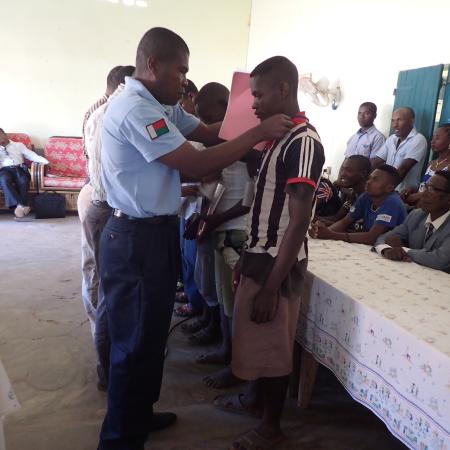
Conscientes de los valores sociales y ecológicos de las praderas marinas, los miembros de la comunidad local de las islas Barren han incluido la preservación de este ecosistema en su convención social llamada Dina, incluido el uso de artes de pesca insostenibles. Hicieron aprobar esta herramienta clave en la gestión y gobernanza local de la pesca por las administraciones de pesca y medio ambiente.
Para garantizar su aplicación y establecer su legitimidad, el Tribunal local ratificó la Dina. Posteriormente, patrulleros comunitarios formados la hicieron cumplir. Por ejemplo, en 2019, los migrantes del sur de Madagascar utilizaron artes de pesca consistentes en redes de enmalle conectadas verticalmente y mosquiteras en el fondo lastradas con piedras. Estos patrulleros informaron directamente a las comunidades y al cogestor del AMP para llegar hasta estos migrantes y explicarles el contenido del acuerdo con respecto a dichas artes de pesca.
La legislación promueve la aplicación de un plan de gestión de la pesca (FMP) como principal herramienta de gestión. En el caso del AMP, el FMP se elaboró mediante un enfoque transparente, participativo e integrador a través de consultas a las comunidades locales. Las comunidades de las islas Barren aprovecharon esta oportunidad para integrar la Dina en un documento marco formalizado. También incluye medidas de gestión adicionales para las actividades pesqueras en las praderas marinas.
Los pescadores decidieron incluir parte de las praderas marinas en las zonas de reserva temporal de pulpo que se cierran anualmente durante unos meses. Observaron que esta decisión favorece el crecimiento del pulpo y protege las praderas marinas y los recursos marinos que contienen. Esta decisión revela su motivación para participar en actividades de gestión y conservación de la pesca.
A nivel de la comunidad local, la cartografía participativa proporcionó datos para la toma de decisiones a nivel local, por ejemplo informando de la selección de zonas de reserva temporales y permanentes. Además, ha fomentado la cohesión social y ha propiciado un mayor compromiso con la conservación. En general, hemos observado una mayor apropiación de la gestión sostenible de la pesca por parte de los pescadores locales, lo que ha contribuido a la aplicación de un programa de conservación. Creemos que esta participación activa de los miembros de la comunidad local también ayudó a convencer a los que aún dudaban de implicarse en la gobernanza local de la AMP.

